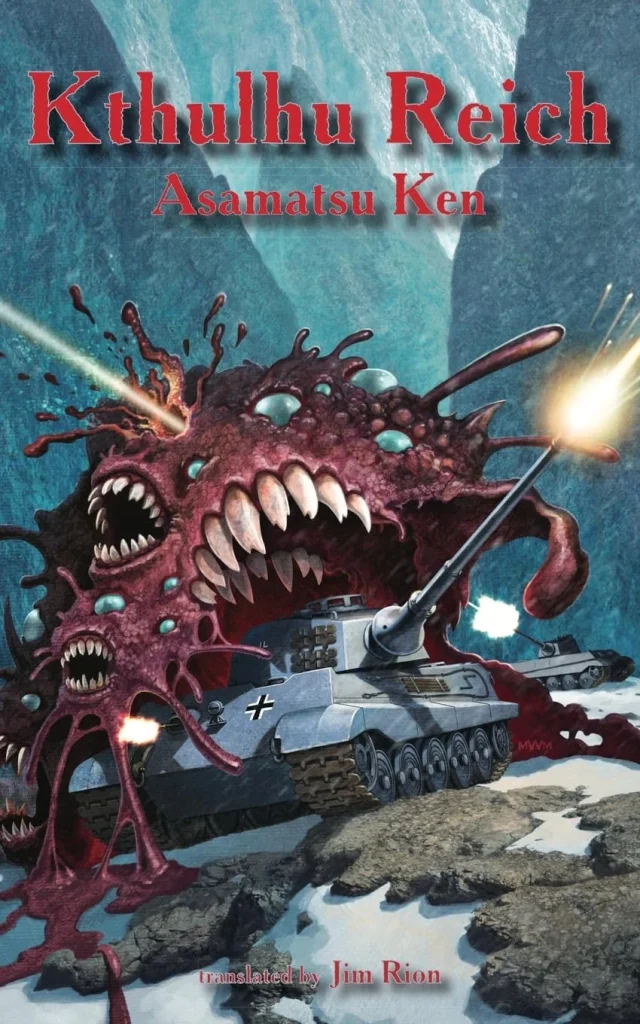
translated from the Japanese by Jim Rion
May 29, 2019
252 pages
grab a copy at your local independent bookstore or library
What is this collection about, you ask?
Short answer: Cthulhu mythos + Nazis
Long answer: A collection of stories written on the theme of evil as manifested in Nazism and the monstrous creatures created and developed by H. P. Lovecraft as part of his Cthulhu mythos, Kthulhu Reich offers readers a unique perspective on this mash-up. Asamatsu, who worked at Kokusho Kankōkai (the publisher of Lovecraft in Japan) and published many of his own works of weird fiction and horror, asks us to think more deeply about the nature of evil and especially the now-well-known Nazi obsession with the occult. Why were many high-ranking Nazis so interested in black magic, ancient monsters, and evil spells? What if the Nazis had been able to tap into some ancient knowledge to bolster their strength against the Allies?
Now, I’ve read very little Lovecraft, and personally find the whole “this creature is SO evil and SO awful and SO scary that to look upon it is to become mad” thing a little boring, but Asamatsu, especially in the latter stories, deftly balances the mystery, horror, and historical components. The extensive endnotes, far from distracting the reader, offer useful information for readers (like myself) who know little or nothing about Lovecraft’s fictional worlds and the extensive 19th-century British and American occult scenes (for Lovecraft + Sherlock Holmes, see Rodolfo Martinez’s The Wisdom of the Dead). Asamatsu also includes mini biographies of Nazis like Himmler and Rommel that illuminate aspects of their political lives that even those of us who have read a lot about WWII wouldn’t necessarily know.
Like I said earlier, the latter stories are, in my opinion, the stronger stories in Kthulhu Reich, though I’d be lying if I said that the first few weren’t entertaining. They’re quite entertaining, dear reader. “The Mask of Yoth Tlaggon” is especially…well…bizarre. A Japanese spy travels to Berlin to find out Hitler’s plans for the Soviet Union and winds up getting pulled into an over-the-top plot to steal an evil mask before Himmler can get it. The mask, however, is controlled by an insane and powerful magus who succeeds in killing almost everyone involved in the plot, except of course for the Japanese spy and the beautiful German actress-but-really-a-spy Clara Hafner. The following story, “In the Wasteland of Madness” (modeled on Lovecraft’s own “At the Mountains of Madness”), follows a couple of middle-rank Nazis who are exiled to Antarctica for not toeing the party line. As part of their penance, they must work with fellow soldiers to build up a military base near a mysteriously warm Antarctic oasis. Ultimately, the goal is to contact the ancient creatures living beyond the mountains and harness them for the Nazis’ evil purposes. Of course, of course, the evil, disgusting, human-hungry creatures wake up and start snacking on the most handy people…namely, the German soldiers. Trust me, you’ll be cheering your way through this one.
“A Feast for the Children of the Night,” “Gigantomachia 1945,” and “Dies Irae” are the most sophisticated and complex of the collection, seamlessly weaving together the threads of horror, gothic, and weird to leave the reader dreading the nightmares to come. In “A Feast,” a small group of Nazi soldiers get lost in a thick fog in Romania on their way to support the German invasion of Ukraine. Ok, it may seem like a fog, but it’s actually a kind of evil miasma, which knocks the soldiers out until they’re found by some villagers. With mounting horror, we read about the cold-blooded execution of the village priest, and then the mayor, followed by the introduction of the Countess Katarina (a Dracula figure) convincing the highest-ranking Nazi to destroy a magical stone keeping her and her “children” enclosed in their castle on the mountaintop. Already an agent of evil, Lieutenant Weil becomes Katarina’s lapdog and unleashes on the village an ancient murderous vengeance that ultimately engulfs the soldiers, as well.
“Gigantomachia 1945” is set on a U-boat that’s been smuggled into international waters on its way to South America. There, according to the plan, the mysterious high-ranking Nazi on board will set up the Fourth Reich and carry on Hitler’s vision. Drawing on Verne’s 20,000 Leagues and Lovecraft’s stories about sinister creatures of the deep, Asamatsu creates a thrilling story of forbidden magic and inhuman menace. Finally, “Dies Irae” tells the always-compelling story of one of the plots to assassinate Hitler, only in Asamatsu’s story, the conspirators discover the existence of an ancient evil creature worming his way into Hitler’s confidence to help him in his goal of world domination. Despite the fact that we already know that this plot fails, like the others before it, we’re left holding our breath while the conspirators plan where to put the bomb and when. A richly-detailed and compelling story, “Dies Irae” is a perfect conclusion to the wild ride that is Kthulhu Reich.
